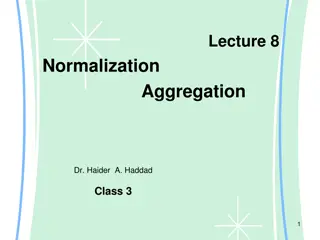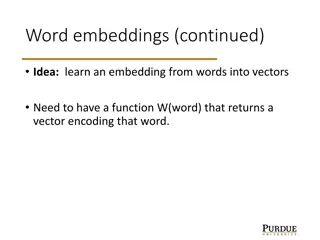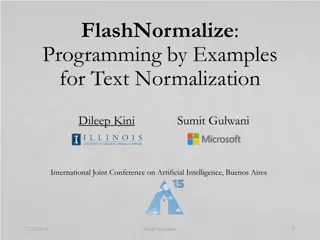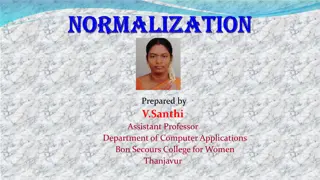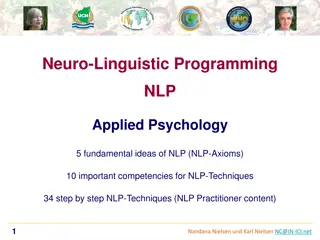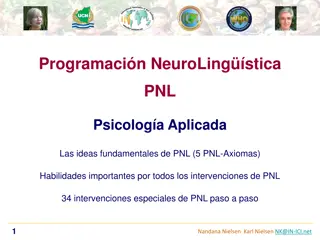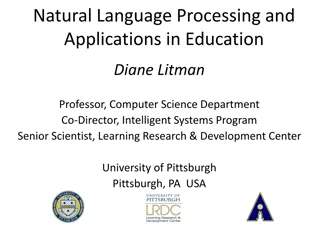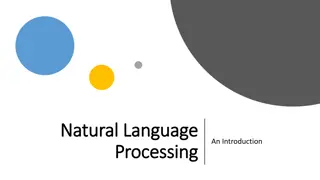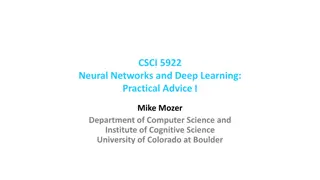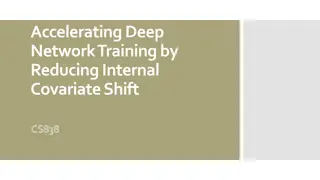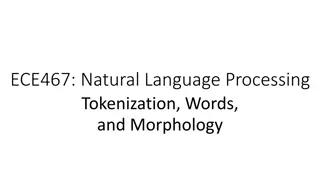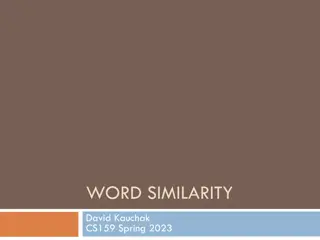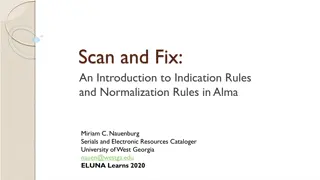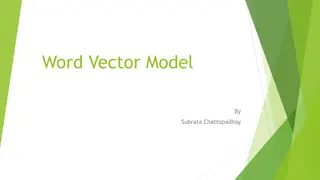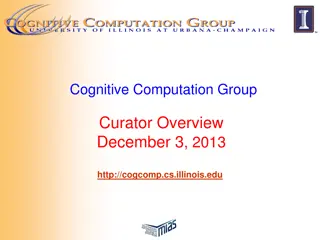Word Normalization and Stemming in NLP
Word normalization is an essential preprocessing step in text data handling. It involves transforming text into a common form to ensure consistency in token recognition. This process helps in recognizing base forms of words through techniques like stemming and lemmatization. Normalization is crucial for tasks like information retrieval, where indexed text and query terms need to match specific forms. Additionally, it involves handling country and organization names, enforcing specific formats on values, and even performing spelling corrections. Case folding, lemmatization for reducing variant forms, and the importance of lemmatization in tasks like machine translation are also discussed in the context of text normalization.
Download Presentation

Please find below an Image/Link to download the presentation.
The content on the website is provided AS IS for your information and personal use only. It may not be sold, licensed, or shared on other websites without obtaining consent from the author.If you encounter any issues during the download, it is possible that the publisher has removed the file from their server.
You are allowed to download the files provided on this website for personal or commercial use, subject to the condition that they are used lawfully. All files are the property of their respective owners.
The content on the website is provided AS IS for your information and personal use only. It may not be sold, licensed, or shared on other websites without obtaining consent from the author.
E N D
Presentation Transcript
NLP Lecture 5 Word Normalization and Stemming
Normalization Preprocessing of text data before storing or performing operations on it. Text normalization is the process of transforming text into a single canonical form that it might not have had before. Normalization = need to recognize tokens and reduce them to the same common/specific form Words/tokens may have many forms , but more often they are not important and we need to know only the base form of the word and can be done by Stemming and Lemmatization.
Normalization Need to normalize terms Information Retrieval: indexed text & query terms must have same form. We want to match U.S.A. and USA We implicitly define equivalence classes of terms e.g., deleting periods in a term Alternative: asymmetric expansion: Enter: window Search: window, windows Enter: windows Search: Windows, windows, window Enter: Windows Search: Windows Potentially more powerful, but less efficient
Normalization Countries the US -> USA U.S.A. -> USA Organizations UN -> United Nations Values Sometimes we want to enforce some specific format on some values of some types e.g: phones (+7 (800) 123 1231, 8-800-123-1231 => 0078001231231) dates, times (e.g. 25 June 2015, 25.06.15 => 2015.06.25) currency (\$400 => 400 dollars) 4
Normalization Often we don't care about specific value, only what this value mean, so we can do the following normalization: \$400 => MONEY email@gmail.com => EMAIL 25 June 2015 => DATE +7 (800) 123 1231 => PHONE etc Spelling Corrections: Also in Natural Languages there are spelling mistakes. In many applications it's useful to correct them. e.g. infromation -> information 5
Case folding Applications like IR: reduce all letters to lower case Since users tend to use lower case Possible exception: upper case in mid-sentence? e.g., General Motors Fed vs. fed SAIL vs. sail For sentiment analysis, MT, Information extraction Case is helpful (US versus us is important)
Lemmatization Reduce inflections or variant forms to base form am, are, is be car, cars, car's, cars' car Lemmatization: keeping only the lemma produce, produces, product, production => produce the boy's cars are different colors the boy car be different color Lemmatization: have to find correct dictionary headword form Machine translation Spanish quiero ( I want ), quieres ( you want ) same lemma as querer want
Morphology Morphemes: The small meaningful units that make up words Stems: The core meaning-bearing units Affixes: Bits and pieces that adhere to stems Often with grammatical functions
Stemming Stemming: keeping only the root of the word (usually just deleting suffixes) Reduce terms to their stems in information retrieval Stemming is crude chopping of affixes language dependent e.g., automate(s), automatic, automation all reduced to automat. economy, economic, economical, economically, economics, economize => econom
Porters algorithm The most common English stemmer Step 1a: sses ss caresses caress ies i ponies poni ss ss caress caress s cats cat Step 1b: (*v*)ing (*v*)ed walking walk sing sing plastered plaster Step 2 (for long stems): Ational Izer ize Ator ate ate relational relate digitizer digitize operator operate Step 3 (for longer stems): al able ate revival reviv adjustable adjust activate activ
Viewing morphology in a corpus Why only strip ing if there is a vowel? (*v*)ing walking walk sing sing
Viewing morphology in a corpus Why only strip ing if there is a vowel? (*v*)ing walking walk sing sing tr -sc "A-Za-z" \n < shakes.txt | grep ing$ | sort | uniq -c | sort -nr 1312 King 548 being 541 nothing 388 king 375 bring 358 thing 307 ring 152 something 145 coming 130 morning tr -sc "A-Za-z" \n < shakes.txt | grep "[aeiou].*ing$" | sort | uniq -c | sort nr | more 548 being 541 nothing 152 something 145 coming 130 morning 122 having 120 living 117 loving 116 Being 102 going
Dealing with complex morphology is sometimes necessary Some languages requires complex morpheme segmentation Turkish Uygarlastiramadiklarimizdanmissinizcasina `(behaving) as if you are among those whom we could not civilize Uygar `civilized + las `become + tir `cause + ama `not able + dik `past + lar plural + imiz p1pl + dan abl + mis past + siniz 2pl + casina as if
Sentence Segmentation and Decision Trees
Sentence Segmentation !, ? are relatively unambiguous Period . is quite ambiguous Sentence boundary Abbreviations like Inc. or Dr. Numbers like .02% or 4.3 Main challenge: distinguish between full stop dot and dot in abbreviations Build a binary classifier Looks at a . Decides EndOfSentence/NotEndOfSentence Classifiers: hand-written rules, regular expressions, or machine-learning
Determining if a word is end-of-sentence: a Decision Tree
More sophisticated decision tree features Case of word with . : Upper, Lower, Cap, Number Case of word after . : Upper, Lower, Cap, Number Numeric features Length of word with . Probability(word with . occurs at end-of-s) Probability(word after . occurs at beginning-of-s)
Implementing Decision Trees A decision tree is just an if-then-else statement The interesting research is choosing the features Setting up the structure is often too hard to do by hand Hand-building only possible for very simple features, domains For numeric features, it s too hard to pick each threshold Instead, structure usually learned by machine learning from a training corpus
Decision Trees and other classifiers We can think of the questions in a decision tree As features that could be exploited by any kind of classifier Logistic regression SVM (Support Vector Machine) Neural Nets etc.
Unix for Poets Text is available like never before The Web Dictionaries, corpora, email, etc. Billions and billions of words What can we do with it all? It is better to do something simple, than nothing at all. You can do simple things from a Unix command-line Piping commands together can be simple yet powerful in Unix It gives flexibility. Exercises to be addressed Count words in a text Sort a list of words in various ways Extract useful info from a dictionary etc
Tools grep: search for a pattern (regular expression) sort uniq c (count duplicates) tr (translate characters) wc (word or line count) cat (send file(s) in stream) echo (send text in stream) head tail join Prerequisites > < | CTRL-C
Count words in a text Input: text file (test.txt) List of words in the file with freq counts tr -sc 'A-Za-z' \n < test.txt | sort | uniq c tr -sc A-Za-z \n < test.txt | sort | uniq -c | head n 5 Merge upper and lower case by downcasing everything tr -sc 'A-Za-z' \n < test.txt | tr 'A-Z' 'a-z' | sort | uniq c How common are different sequences of vowels (e.g., ieu) tr -sc 'A-Za-z' \n < test.txt | tr 'A-Z' 'a-z' | tr -sc 'aeiou' '\n' | sort | uniq -c
Sorting and reversing lines of text sort sort -f sort -n sort -r sort -nr Ignore case Numeric order Reverse sort Reverse numeric sort echo Hello





